These California bills would train nurses, judges and police how to spot their own biases

- Share via
Reporting from Sacramento — California saw a decrease in the number of women who died giving birth in 2013, as the maternal mortality rate climbed across the country, according to state officials. But expectant black mothers across the state are still three to four times more likely to die from complications at childbirth than white women.
State health researchers say the wide disparity probably isn’t attributed to social factors, such as patients’ levels of education or socioeconomic backgrounds. Instead, they point to evidence of racism and implicit bias in the medical community: A survey of white medical students and residents published in 2016 by the University of Virginia found that roughly half of those who participated believed myths about biological racial differences, including that black patients tolerate more pain and have thicker skin.
“That wasn’t in 1816, colleagues. That was in 2016,” state Sen. Holly Mitchell (D-Los Angeles) said at a recent Senate Health Committee hearing. “Black women are in grave danger because when they say they are in pain … some providers do not believe that and lack the cultural competency to respond appropriately.”
Two state lawmakers hope to address the issue this year with proposals that would require training for nurses, doctors and other medical professionals on how to spot implicit bias on the job. The legislation is part of a broader push to tackle the unconscious perceptions and stereotypes that contribute to discrimination and disparities in treatment in the medical field and other industries, and can play a role in instances where life and death hang in the balance.
Mitchell’s Senate Bill 464, which cleared its first committee vote in the Senate this month, would create a training program to help perinatal healthcare providers identify and correct their biases. It would task the state public health department with collecting better data on maternal mortality rates, and require hospitals to provide patients with more information on how to file discrimination complaints.
Under a package of bills by state Assemblywoman Sydney Kamlager-Dove (D-Los Angeles) due for their first committee hearings this week, doctors, physician assistants and nurses would have to undergo eight hours of implicit bias training and testing within two years of receiving their licenses and every two years thereafter. Similar training would be established for police officers and court officers, including judges, bailiffs, clerks and trial lawyers.
The high mortality rate for expectant black mothers in California and across the country has also received attention in Congress and in the 2020 presidential campaign, as Democrats have introduced plans to expand healthcare access for pregnant women and to address prejudices that affect how black patients are treated.
Although the state legislation has not not been publicly opposed, Kamlager-Dove said she has faced some pushback in private meetings with lawmakers and potential backers.
“No one likes to be told what to do and no one thinks they’re a racist, so the question I hear a lot is, ‘Why do we need this?’ ” she said. “The goal is not to have punitive legislation. It is to help people acknowledge they have [implicit biases] and help reduce them.”
University researchers have found all people have implicit biases, or unconscious perceptions, both positive and negative, that can influence behavior. Studies suggest such internal belief systems have had an effect across a variety of industries: Women were more likely to survive a heart attack when seen by female physicians. Prosecutors are more likely to charge black suspects than white suspects in similar cases. And many orchestras now have candidates audition behind blind screens to prevent gender bias from affecting their decisions; some go so far as to hold tryouts in rooms with carpeted floors to muffle the sound of a candidate’s heels.
Discrimination and implicit bias against African American women in medical rooms traces to the earliest days of gynecology, when the field’s “modern father,” James Marion Sims, conducted tests without anesthesia on enslaved black women in the 1800s to develop the first surgical procedures in women’s reproductive health.
In recent years, as U.S. health officials saw the national maternal mortality rate rise, California state health officials invested funds in research, upgraded healthcare and developed tools to better assess the needs of women. The state’s maternal mortality rate dropped by 55% between 2006 and 2013, according to an analysis by the California Birth Equity Collaborative, a pilot program founded by state health officials and the Stanford University School of Medicine.
The maternal mortality rate for white women in the state now stands at 4.7 deaths per 100,000 live births, compared with 3.1 for Hispanic women and 4.1 for Asian and Pacific Islander women, according to a 2018 study by the United Health Foundation and the American Public Health Assn. But the mortality rate for black expectant mothers is 17.4.
The disparities remain even when controlling for socioeconomic factors, state and local health researchers said. In Los Angeles County, pregnant African American women with a bachelor’s degree or higher had worse birth outcomes, including deaths, or babies born prematurely or at lower weights, than white women who did not complete high school, according to county health officials.
When testifying in favor of Mitchell’s proposal, health advocate Janette Robinson-Flint told members of the state Senate Health Committee this month, “Black women have been left behind.”
“Four hundred years ago, the Good Ship Jesus brought enslaved Africans to the shores of Jamestown, Va., and since then, black women have been systematically dehumanized,” said Robinson-Flint, who co-founded Black Women for Wellness, a grass-roots organization that offers programs for pregnant women.
She said that she and other policy advocates have collected a number of cases that capture how black women continue to face verbal abuse, discrimination and racism from doctors, nurses and medical assistants.
One 19-year-old was denied ultrasounds at two emergency rooms because she was told that “‘if she was old enough to get pregnant, she was old enough to have this baby naturally,’ ” Robinson-Flint said.
Kira Johnson, who spoke four languages, lived in China and ran several businesses, died after giving birth to her second son, Langston, because of complications that arose from a routine cesarean section. Doctors found three liters of blood in her abdomen, according to a wrongful death lawsuit filed against the Cedars-Sinai Medical Center.
“After 10 hours of watching Kira suffer in excruciating pain needlessly, after 10 hours of begging and pleading them to help her, the medical staff at Cedars-Sinai finally took action,” her husband, Charles Johnson IV, told federal lawmakers at a U.S. House hearing in September.
Training alone is not enough to target implicit bias, and should not distract from ongoing efforts to target more overt forms of racism and prejudice, said Kelly Capatosto, senior research associate at the Kirwan Institute for the Study of Race and Ethnicity at Ohio State University. Still, she and other experts called California’s legislative proposals “a step in the right direction.”
“California is at the forefront in considering the legal ramifications around implicit bias,” she said. “A lot of states haven’t done so much as acknowledge the problem.”
In the criminal justice system, attention to the need for bias training has emerged from the rise of the Black Lives Matter movement and the evolution of social media, which has prompted greater recognition of law enforcement’s disparate use of force against black, Latino and other people of color, said Demarris Evans, a San Francisco deputy public defender and chair of the office’s Racial Justice Committee.
Evans, who has been working with San Francisco police officers to address biases over the last two years, wrote a letter on behalf of the committee in support of Kamlager-Dove’s bill to require training for all police officers, calling it “a good start.”
“It should be incorporated throughout their work,” she said. “There should be training and references back to implicit bias in regular meetings and debriefings, not a one-time thing you are involved in every other year.”
California Supreme Court Chief Justice Tani Cantil-Sakauye also has expressed support for implicit bias training for judges. In her State of the Judiciary address last month, she said Judicial Council Administrative Director Martin Hoshino has already made unconscious bias training mandatory for all court administrative employees.
“He recognizes the science, as do I, that the formation of unconscious stereotypes can affect attitudes, actions, and beliefs in all encounters where we meet someone different from ourselves,” she said.
She has asked Hoshino to review the statewide judicial educational curriculum to ensure the training is available for all judges. And she said she planned on taking the first class.
More stories from Jazmine Ulloa »
Follow @jazmineulloa on Twitter.
More to Read
Get the L.A. Times Politics newsletter
Deeply reported insights into legislation, politics and policy from Sacramento, Washington and beyond. In your inbox three times per week.
You may occasionally receive promotional content from the Los Angeles Times.











